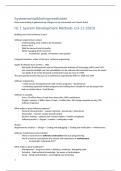Systeemontwikkelingsmethoden
Deze samenvatting is gebaseerd op colleges van de Universiteit van Utrecht (inku)
Hc 1 System Development Methods (13-11-2023)
Building non-trivial software is hard
Software engineering is about:
- Understanding what needs to be developed
- How to do it
- With the desired level of quality
- While managing finite resources
o In particular, people, sometimes many people
Margaret Hamilton, coiner of the term ‘software engineering’
Apollo 8 software team at MIT, c. 1965
- Het Apollo 8-softwareteam aan het Massachusetts Institute of Technology (MIT) rond 1965
was verantwoordelijk voor het ontwikkelen van de software die essentieel was voor de missie
van Apollo 8, de eerste bemande ruimtevlucht naar de maan in 1968.
The term gained traction because of 2 conferences organized by NATO in 1968 and 1969
Software engineering
= multi-version development of multi-version programs – David Parnas
= combining separately written programs and making them suitable for use by people who
had not written them = Fred Brooks
Software is complex
- Linux: 25 million lines of code from more than 1600 contributors
- Google’s systems: 2 billion lines of code, 9 million files, 40k change requests per day, 25k
software engineers
What makes a great software engineer?
- Personal characteristics – always impriving / passionate / data-driven
- Teammates – honest/ creates shared context
- Decision making – updates their mental models / handles complexity
- Software product – elegant / creative / anticipates needs
Phases
Requirements analyses -> Design -> Coding and debugging -> Testing and verification -> Maintenance
Software maintenance and evolution
- There is much more to software construction than just programming
- And it is hard to overestimate the volume and importance of maintenance
o An example: Cyberpunk 2077
What makes a great maintainer?
- Management – long term vision / defining a roadmap / delegating tasks
- Technical – high technical knowledge / be aware of technologies
- Social – being careful/polite / encouraging and mentoring
1
, - Personality – foster innovation / focus on the project goal
A silver lining: at least we don’t need to build everything from scratch
Object-oriented analysis
- Before designing software, you need to determine what to build
- The process of discovering, documenting and maintaining the requirements of a software
system
o Figuring out what the problem is
o What does the customer want?
o How can I translate a customer’s wishes to a design?
o Who is the customer?
Analysis: Who are the stakeholders?
Object-oriented design
- How should I organize code into functions and classes?
- How are classes related?
- What are the tradeoffs (compromises) of organizing a system in a certain way?
- What are the properties of a good design?
Analysis and design
- Analysis is a soft skill: talking to customers and figuring out what they want
- Design is more technical:
o Figuring out the right high-level structure of your code
o Making decisions and accounting for trade-offs
2
,Hc2 (15-11-2023)
Object oriented programming
Innards of a turtle
Pieces of information associated with a turtle:
- Position
- Pen color
- Direction to which it points
- Whether the pen is visible or not
- Drawing or not
- And much more
Turtle can do many things:
- Advance
- Rotate
- Change the drawing color
- Stop drawing
- Go back to drawing
The turtle stores many pieces of data:
- Its position
- Drawing color
- Direction to which the pen points
- Whether the pen is visible
What the turtle does affects what it stores
Turtle objects
- Bij turtle wordt er dingen opgeslagen, maar er worden geen variabelen aangepast/
opgeslagen. Er worden dus dingen opgeslagen (bv kleur en richting), maar we weten niet
waar het wordt opgeslagen en dat maakt ook niet uit.
- Turtle is een object
o Object = variables die state + behavior OF variables + functions aangeeft
o every value in python is an object
Objects
- Constructor = special function that every object has
o t = Turtle()
- They are values
o Can be stored in variables, passed as arguments, returned by methods
- Their internal variables (fields or attributes) are manipulated by their functions (methods)
Objects are a mechanism for encapsulation
- -> you don’t need to know how an object represents itself internally, you just need to know
about it’s functions
- Information hiding
We don’t need to know how they represent their internal states
3
, Advantages of invoking functions instead of directing variable:
- You can do things other than changing the position
- You don’t need to know how the elements are represented (it could be 2 strings or variables
or whatever)
You should be able to work with objects, even if you don’t know how they work internally. You should
be able to work with the interface (methods).
Lists are encapsulated
- We don’t know how a list represents a sequence of number internally
o dit kan namelijk op verschillende manieren gedaan worden
- nor how sorting is performed by the sort() function
The state of an object is independent of other objects of the same type
- different object have same state elements (every turtle keeps track of number of position),
but they are completely independent.
Objects use reference semantics
- = Als je een lijst hebt genaamd ‘s’ en die naam veranderd in ‘l’. Vervolgens voeg je een getal
toe aan lijst ‘l’. Dan vraag je om ‘s’ uit te schrijven en zit het nieuwe toegevoegde getal erin!
o L = [1,2,3,4,5]
o S=L
o L.append(42)
o S
Output: [1,2,3,4,5,42]’
o L[0:2]
Output: [1,2]
o L.apend(000)
o L
Output: [1,2,3,4,5,42,0)
o S
Output: [1,2,3,4,5,42]
Als we de lijst ‘L’ veranderen, verandert het de lijst ‘S’ dus niet, andersom werkt
referentie dus niet!
- Assignment doesn’t copy value, but copies address (=reference)
- Assignments create references to objects, instead of copies
4





